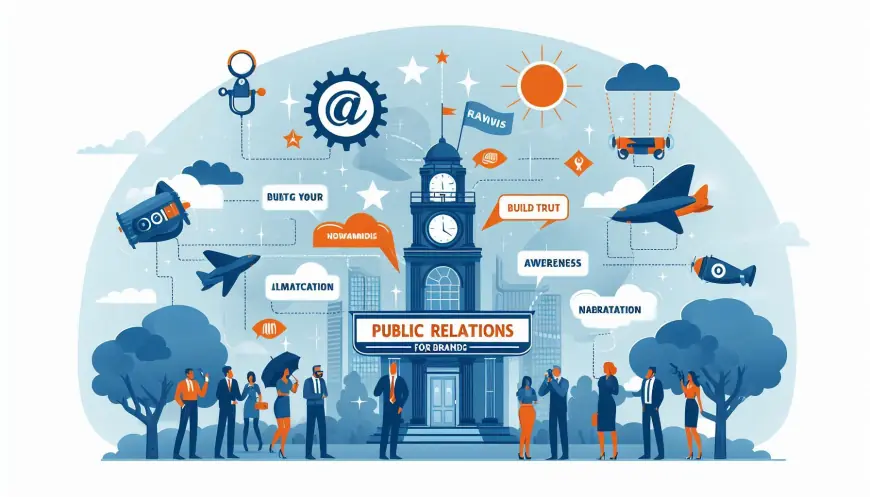Public Relations for Brands: Build Trust and Awareness
Public relations for brands is the strategic communication process used to build and maintain a positive reputation with audiences.

What Is Public Relations for Brands?
Public relations for brands is the strategic communication process used to build and maintain a positive reputation with audiences. PR plays a critical role in shaping public perception, driving brand awareness, and establishing trust. Through proactive storytelling, media engagement, and crisis management, brands can control their narrative and connect with customers, investors, and other stakeholders.
From crafting compelling press releases to managing media outreach, PR professionals work to ensure the brand message aligns with its core values. Agencies like Brandraz specialize in creating impactful public relations strategies that strengthen brand presence and influence.
Why Public Relations Is Important for Brands
Public relations supports brand growth and longevity in several ways:
- Building Credibility: Media coverage and thought leadership enhance trustworthiness.
- Creating Awareness: PR efforts increase visibility among target audiences.
- Shaping Brand Perception: Effective messaging ensures the brand is seen in a positive light.
- Managing Crises: PR mitigates negative incidents and protects brand reputation.
- Strengthening Customer Relationships: Engaging communication builds loyalty and satisfaction.
When executed well, public relations becomes a powerful tool for long-term success.
Key Elements of Public Relations for Brands
Public relations involves several core components that work together to achieve strategic goals:
- Media Relations: Building relationships with journalists and influencers to secure media coverage.
- Crisis Management: Addressing issues swiftly to protect the brand’s reputation during challenging times.
- Content Creation: Crafting press releases, blog posts, and other content to tell the brand’s story.
- Event Management: Organizing product launches, conferences, or campaigns to engage audiences.
- Social Media PR: Leveraging social platforms to interact with the audience and share updates.
Combining these elements ensures a comprehensive approach to public relations.
Steps to Develop a PR Strategy for Brands
Developing an effective PR strategy requires careful planning and execution. Follow these steps:
- Define Goals: Identify specific objectives, such as improving visibility or managing crises.
- Understand Your Audience: Tailor messaging to resonate with your target demographic.
- Craft Key Messages: Develop consistent and memorable messages that reflect your brand identity.
- Choose PR Tactics: Select the right mix of media outreach, social engagement, and content marketing.
- Measure Results: Track media coverage, engagement, and sentiment to evaluate success.
A clear strategy helps align PR efforts with the brand’s overall goals.
Examples of Successful Public Relations for Brands
Many global brands have successfully used public relations to elevate their presence. Some notable examples include:
- Coca-Cola’s CSR Campaigns: Coca-Cola’s initiatives, such as sustainability programs, reinforce its reputation as a socially responsible brand.
- Tesla’s Thought Leadership: Tesla’s CEO Elon Musk uses PR to position the company as a leader in innovation and sustainability.
- Airbnb’s Crisis Response: Airbnb turned negative press into an opportunity by publicly addressing safety concerns and implementing trust-building measures.
These examples demonstrate the impact of thoughtful and proactive public relations strategies.
The Role of Social Media in Modern PR
Social media has revolutionized public relations, offering direct communication with audiences. Key ways to use social media for PR include:
- Announcing News: Share product launches, updates, or press releases on platforms like Twitter and LinkedIn.
- Engaging with Followers: Respond to comments and messages to build stronger connections.
- Leveraging Influencers: Partner with influencers to expand reach and credibility.
- Monitoring Brand Mentions: Use social listening tools to track conversations and sentiment about your brand.
Social media complements traditional PR efforts and amplifies brand messaging.
Benefits of Public Relations for Brands
Investing in public relations offers several advantages for brands:
- Enhanced Visibility: PR increases media coverage and public awareness.
- Improved Credibility: Positive press and endorsements build trust.
- Customer Loyalty: Transparent communication fosters stronger relationships with customers.
- Competitive Edge: A well-executed PR strategy differentiates your brand in the marketplace.
- Reputation Protection: Proactive management reduces the impact of negative incidents.
These benefits demonstrate why public relations is a cornerstone of brand-building efforts.
How to Handle a PR Crisis
Even the most reputable brands face crises. Effective PR can minimize the damage. Follow these steps:
- Acknowledge the Issue: Be transparent and acknowledge mistakes or incidents publicly.
- Communicate Quickly: Issue a statement to address the situation before it escalates.
- Take Responsibility: Avoid deflecting blame; instead, focus on solutions.
- Provide Regular Updates: Keep stakeholders informed of corrective actions.
- Learn from the Experience: Use the crisis as an opportunity to improve processes and communication.
A solid crisis management plan ensures you can handle unexpected challenges effectively.
The Difference Between PR and Advertising
While both public relations and advertising promote brands, they differ in approach:
| Aspect | Public Relations | Advertising |
|---|---|---|
| Objective | Build trust and credibility | Promote products or services |
| Cost | Earned media coverage, less direct cost | Paid placement, often expensive |
| Tone | Informative, neutral, or persuasive | Direct and promotional |
| Control | Limited (media decides final coverage) | Full control over the message and design |
Both PR and advertising are important, but PR often has a more lasting impact on credibility.
FAQs
What is public relations for brands?
Public relations for brands involves managing communication to shape public perception, build trust, and enhance reputation.
Why do brands need PR?
PR helps brands establish credibility, increase visibility, and manage their reputation during crises or major campaigns.
How does PR differ from marketing?
PR focuses on managing the brand image and building trust, while marketing emphasizes promoting and selling products or services.
What role does content play in PR?
Content like press releases, blogs, and thought leadership articles helps share the brand’s story and reinforce its message.
How do brands measure PR success?
Brands measure PR success by tracking media coverage, social media engagement, audience sentiment, and website traffic.
Can small businesses benefit from PR?
Yes, small businesses can use PR to gain visibility, build credibility, and establish relationships with their audience.
Coming Soon: Media Relations for Branding
In our next, we’ll dive into media relations for branding, exploring how building relationships with journalists and influencers can enhance your brand’s presence. Learn actionable tips for crafting press releases, securing coverage, and making your brand stand out.
For expert guidance on public relations, visit https://brandraz.com/ to explore tailored strategies for your brand.
Suggestions
What's Your Reaction?
 Like
0
Like
0
 Dislike
0
Dislike
0
 Love
0
Love
0
 Funny
0
Funny
0
 Angry
0
Angry
0
 Sad
0
Sad
0
 Wow
0
Wow
0





















































